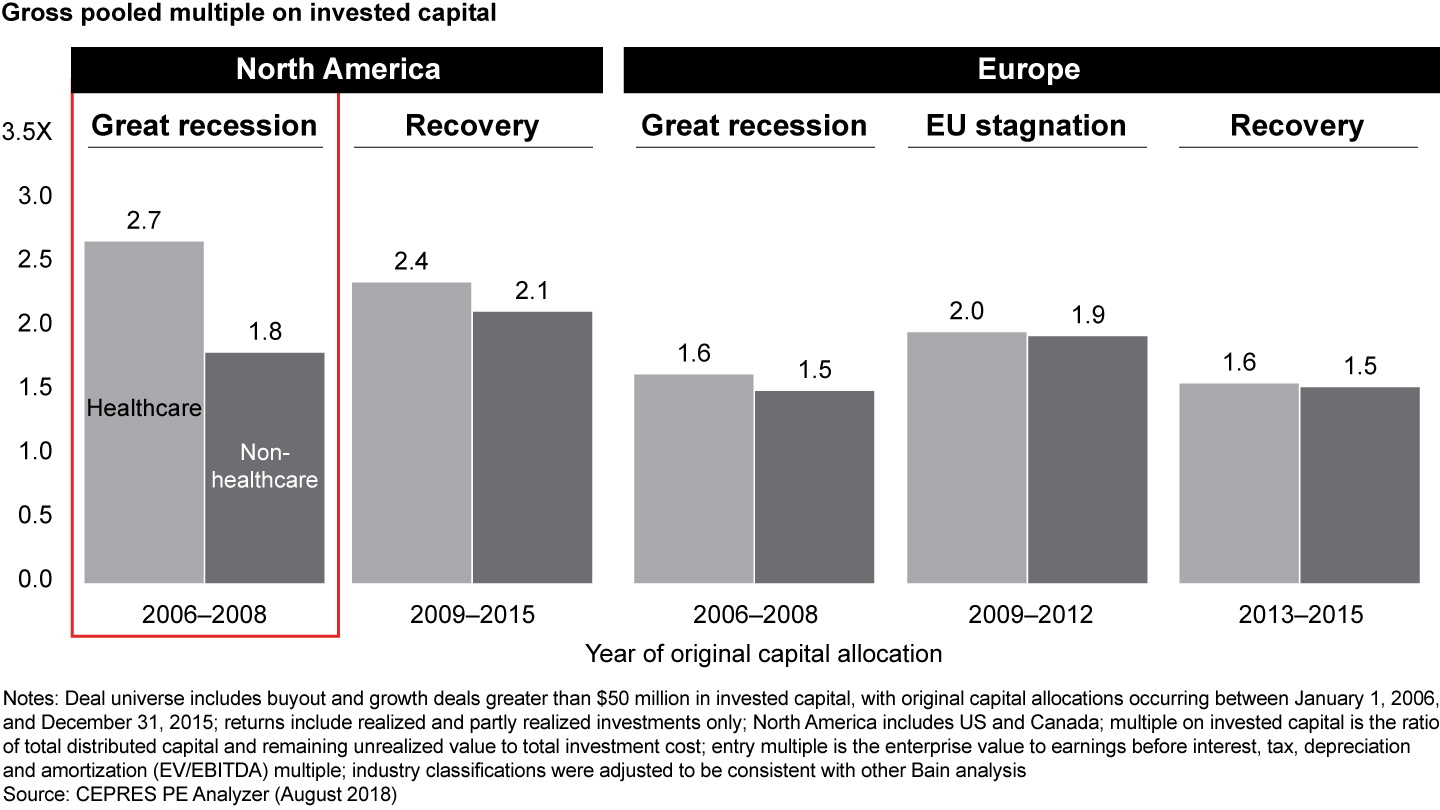Report

This article is part of Bain’s 2019 Global Healthcare Private Equity and Corporate M&A Report. Explore the contents of the report here or download the PDF to read the full report.
Toward the end of 2018, the economic and political winds swirled in new directions. Stock markets around the world retreated on indications that global growth is slowing, most markedly in China. Hawkish actions of central banks hastened the retreat, especially in the US, where the Federal Reserve continued to hike interest rates and unwind its balance sheet simultaneously. The leveraged loan market, which is critical for investors, tightened further as interest rates rose. Political fractures widened in many countries. For example, the US incurred its longest government shutdown, anti-government protests shocked the French government, and the UK’s Brexit negotiations faltered. In short order, the outlook for 2019 grew less certain and investment risks more substantial than a year ago.
Fortunately, underlying healthcare fundamentals tend to be relatively immune to economic cycles, resulting in stable returns, an attractive trait to investors. This is most pronounced in North America, where, according to CEPRES, multiples on invested capital on healthcare PE investments made during recessions meaningfully outperform those in other industries; in Europe, performance is in line with the rest of the market (see Figure 14). As a result, robust fund-raising in 2018 and the existing dry powder provide plenty of capital for healthcare investments. As such, we expect competition for assets will not likely decline in the near future. For all of these reasons, 2019 should be another banner year for healthcare private equity.


Given the strong deal competition, we expect financial sponsors to write larger checks for assets over the year. Yet the willingness to write these larger checks will come with risks, such as exposing a larger portion of a fund to a single investment or taking on more complex assets with multiple businesses. To address this challenge, we expect funds will increasingly partner with corporates and other financial sponsors.
Competitive intensity should also buoy private equity multiples at their current levels, despite an uncertain outlook in public equity markets. In fact, as public valuations erode, funds could look harder at public markets for opportunities. Public companies with noncore healthcare assets dragging on performance will find that financial sponsors are a natural fit for carve-outs. Funds will continue to contemplate take-private deals and launch more focused turnaround efforts. As in 2018, there likely will be opportunities for large transactions from the public market over the coming year.
Relative market share may matter more. As multiple expansion continues to become a smaller component of PE returns, the middle of the market becomes a more difficult place to play, though some funds still could win there. More funds may choose to focus instead on the two ends of the spectrum, where returns look more promising. At one end, investing in large-scale category leaders will give funds a sturdy platform from which to invest. At the other end, buyouts of niche, differentiated companies that can benefit from capital infusion is another attractive option.
Wherever they compete along this spectrum, investors will not only have to execute an airtight acquisition and integration playbook but will also need to flex new muscles and develop more creative approaches to building scale or category-leading assets. For example, TPG Capital announced in early 2019 that it has committed $300 million to build from the ground up an autism behavioral health services platform known as Kadiant. We expect to see a greater prevalence of funds building and adding to platforms, especially in the provider and biopharma sectors, both of which benefit from scale but remain fragmented.
Larger buyout firms will continue to cultivate a budding interest in developing biopharma platforms and taking on clinical-stage risk. The formations of sector-specific vehicles over the past few years, such as Bain Capital Life Sciences and Blackstone Life Sciences, and recent deal experiences have given these large funds both the infrastructure and know-how to execute in the space. They are well positioned to acquire underfunded biopharma programs to develop and bring new drugs to market.
Beyond doing larger or more complex deals, funds likely will take on more risk in the form of healthcare-heavy investments in the provider and payer sectors. The provider sector historically has been attractive for its buy-and-build opportunities, and firms will push further into niche specialties and disruptive care delivery models with nuanced reimbursement and regulatory exposures. On the payer side, firms will continue to look for ways to harness trends involving Medicare Advantage and complex populations. On both fronts, we expect to see more competition from corporates trying to capitalize on their operating experience.
With funds doing new types of deals in a market this competitive and attractive, sponsors will want to invest more in integrated commercial and operational due diligence in order to identify all relevant risks and explore all possible levers of return. We expect funds to be more creative and proactive in their pursuit of winning investment angles. Funds also will invest more heavily in developing a value-creation plan early in the investment life cycle in order to focus the management team on the most critical activities.
While we expect 2019 to be strong for investments, the jury is out on whether this vintage of healthcare deal returns will be as good as previous vintages. As uncertainty permeates public stock and debt markets and returns from multiple expansion wane, more deals may become increasingly difficult to justify. Investors will no longer be able to rely on market-wide multiple expansion to generate returns. There could be a wider fan of outcomes in future deal returns. Disciplined, data-driven funds will find their way to top-quartile deals by backing winning companies, deploying a systematic value-creation playbook and doing their part to transform the global healthcare industry.